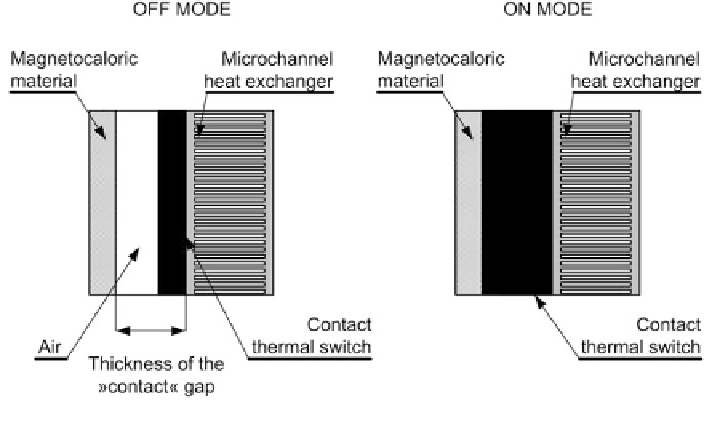Environmental Engineering Reference
In-Depth Information
material, is the thermal contact resistance between the surface of the thermal switch
and the wall of the, e.g. microchannel heat exchanger (heat source or heat sink).
This can signi
uence the heat-transfer irreversible losses as well as the
response time. One should therefore, before focusing on a particular mechanism,
evaluate the feasibility of its application.
Therefore, in order to be applied in magnetic refrigeration, the contact thermal
switch mechanism should operate over a very small distance, e.g. of the order of a
few
cantly in
fl
m. This will be required to minimize the irreversible heat losses, and at the
same time still provide high contact resistance ratio between the ON and OFF
operations. According to the analysed data below, and considering an occupancy
volume of 20 % for the thermal switch material and 80 % for the air in the OFF
mode, the ratio between the contact resistance in the OFF and ON operations varied
from very small values at 1 mm thickness up to maximum of 2 % at a thickness of
10 microns.
In the case below (Fig.
6.10
) we show a simple example of how the thermal
resistance and distance between the contact thermal switch and the wall of the
microchannel heat exchanger in
μ
uences the temperature difference required for the
heat transfer. For this purpose we will estimate the macroscopic (bulk) mechanism
of the thermal diffusion.
We consider the magnetocaloric material to be embodied within the contact
thermal diodes (the thermal contact resistance between the diodes and the mag-
netocaloric material is neglected). For this purpose we investigate gadolinium as the
magnetocaloric material exposed to a magnetic
fl
eld change of about 1 T (an
adiabatic temperature change 4 K). For this case the maximum speci
c cooling
ned to be 1,200 Jkg
−
1
. This has been calculated as the product of the
isothermal entropy change of 4.1 Jkg
−
1
K
−
1
capacity is de
and a temperature of 292 K.
Fig. 6.10 Example of a contact thermal switch (gure shows only the
“
hot
”
part of the device)

Search WWH ::

Custom Search